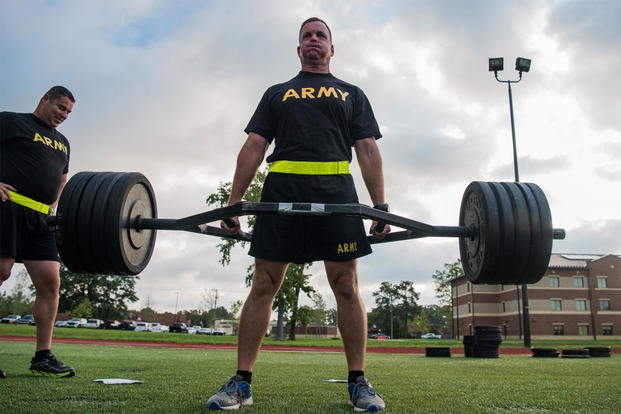Keep those toes pointed out for the deadlift, flex those knees for the medicine ball backwards throw, and don't ever just drop the kettlebells in the sprint-drag-carry -- gotta "place" them on the ground.
Those and other helpful hints for passing the Army's new Army Combat Fitness Test (ACFT) were featured in the launch Friday of a new microsite linked to the Army homepage that includes how-to videos and training plans for the test, which is set to go into effect as early as October 2019.
The Army currently is running pilot programs with 63 battalions on the six-event test to flesh out scoring standards and make any needed adjustments to the requirements.
In July, the Army announced its current three-event Army Physical Fitness Test -- push-ups, sit-ups and a two-mile run -- would be replaced by the more strenuous ACFT.
The six events for the ACFT are:
• Strength Deadlift. This is a three-repetition maximum deadlift to test muscular strength; it mimics movement to safety and effectively lifting and carrying heavy loads.
• Standing Power Throw. This event involves throwing a 10-pound medicine ball as far as possible over the head and to the rear. It measures upper and lower muscular power, balance and whole body flexibility.
• Hand-Raised Push-ups. This event forces the soldier to go all the way to the floor and raise his hands before coming back up again, measuring upper-body muscular endurance.
• A 250-Meter Sprint, Drag and Carry. This is five different events within one event -- a 50-meter sprint; a backward 50-meter drag of a 90-pound sled; a 50-meter movement; a 50-meter carry of two 40-pound kettle bells; and a final 50-meter sprint. It measures muscular strength, power, speed and reaction time.
• Leg Tuck. A soldier hangs perpendicular to the pull-up bar and brings his knees up to his elbows and back down again for one repetition. It measures muscular strength, endurance and grip.
• Two-Mile Run. The ACFT retains the two-mile run portion of the APFT, which is designed to measure aerobic and muscular endurance.
The Army has yet to determine what will happen to soldiers who fail the test, which won't go fully into effect Army-wide until October 2020. But Army Chief of Staff Gen. Mark Milley last month gave fair warning the new test is coming, and soldiers need to get ready.
"If you can't get in shape in 24 months, then maybe you should hit the road," Milley told defense reporters.
"We don't want to lose thousands of soldiers to [the ACFT]. This fitness test is hard. No one should be under any illusions about it," Milley said. "But we really don't want to lose soldiers on the battlefield. We don't want young men and women to get killed in action because they weren't fit," Milley said.
-- Richard Sisk can be reached at Richard.Sisk@Military.com.










